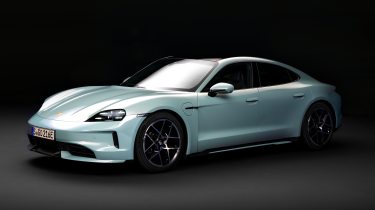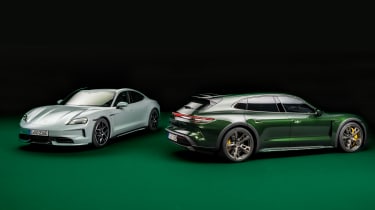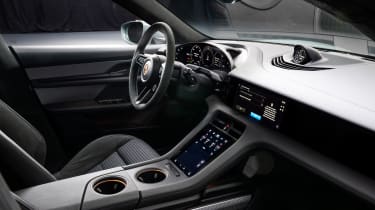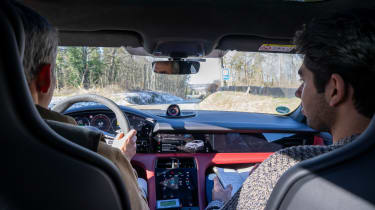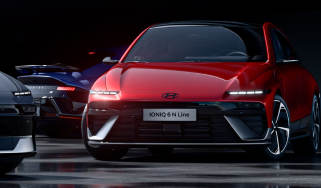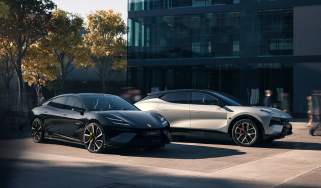New Porsche Taycan – all you need to know
It might look familiar, but the facelifted Porsche Taycan promises huge gains in dynamic potential and everyday usability
Don’t be fooled by the new Porsche Taycan’s mildly tweaked exterior – this is about as comprehensive as facelifts get. With significantly more power, faster charging, longer range and clever new chassis hardware, the updated Taycan promises to raise the bar for premium electric saloons, just as the original did back in 2019.
The new model arrives as part of Porsche’s EV offensive that includes the second-generation Macan and forthcoming electric replacements for the 718 sports car and Cayenne. A new flagship electric SUV – codenamed K1 – will follow later in the decade. Despite sharing much of its 800-volt J1 platform with the original, the revised Taycan offers a generational leap forward on paper thanks to new hardware elements managed by more advanced software.
For the flagship Turbo S, the headline figures are astonishing. Thanks to a more powerful rear motor and a new ten-second ‘push-to-pass’ overboost function, peak power has risen to 939bhp (up from 750bhp), trimming the 0-62mph time down by four-tenths to 2.4sec. The Tesla Model S Plaid’s 1.99sec 0-60mph sprint might grab more headlines, but this was achieved with the one-foot rollout subtracted.
Lesser models get a power boost too, with the base rear-drive Taycan generating 429bhp (+27bhp) and the 4S offering 590bhp (+67bhp). The Taycan Turbo is rated at 872bhp – an enormous uplift of 201bhp. An updated thermal management system with improved cooling should offer more consistent, repeatable performance than before.
Despite the extra power, the new Taycan can also go further on a charge (as much as 35 per cent further, depending on the model). Porsche has increased the usable capacity of the Taycan’s optional Performance Battery Plus to 97kWh, enabling up to 421 miles from a full battery in the base model. The 4S achieves 399 miles, with the Turbo and Turbo S covering up to 391 miles.
A raft of efficiency improvements in the drivetrain, plus optimised regen software and rolling resistance also help make better use of each available kWh, and a higher 320kW peak charging speed allows for a 10-80 per cent top-up in just 18 minutes – more than 3 minutes faster than before.
Improved aerodynamics also help eke out extra range. Porsche has refined the Taycan’s design with a new front fascia, redesigned matrix LED headlights and a revised rear light bar. The front wings have been reprofiled too, and Turbo and Turbo S models now receive bespoke bumpers and grey badging to differentiate them from lesser models.
The new Taycan is also up to 15kg lighter than before despite improved standard equipment levels – you can thank the new rear motor and a lighter, more energy-dense battery pack for that. The weight reduction doesn’t mean much in the context of the Taycan’s two-ton-plus kerb weight (the dual-motor Turbo comes in at 2290kg), but Porsche has invested in a raft of sophisticated new chassis technology to heighten its abilities as a sports saloon.
All Taycans are fitted with two-chamber air suspension as standard, with new two-valve adaptive dampers allowing for independent compression and rebound adjustments on the fly. Everything from the steering and front-to-rear torque management has been re-tuned for the second-generation model, but the key differentiator is Porsche’s new Active Ride system.
Available as an option, Active Ride enables precisely controlled suspension forces at each wheel by using hydraulic motor pump units at both axles. Using ‘6D’ sensors, the system can precisely determine the car’s attitude and apply the necessary suspension forces to maintain a level platform.
The driver can also choose from specific settings to overcompensate for pitch and roll, allowing the car to lean into corners or tilt forwards under acceleration, for example. We’ve experienced Active Ride from the passenger seat of a Taycan prototype, and its ability to resist body movements – even under full acceleration and high cornering loads – is uncanny.
More configurability is available through a new approach to drive modes – the Taycan’s Normal, Sport and Sport Plus programs can now be tailored individually. The infotainment interface has also been updated to present information more clearly to the driver, and offers Apple’s new CarPlay+ smartphone integration.
The new Taycan receives a price uplift across the board – unsurprisingly given the extent of the update – with the rear-drive model starting from £86,500. Stepping up to the 4S costs an additional £9400, with the Turbo and Turbo S stretching up to £134,100 and £161,400 respectively. As before, Cross Turismo and Sport Turismo estate body styles are also available.
We expect a revised GTS model to arrive in due course, but the most hotly anticipated new Taycan is the Turbo GT. The new flagship is being developed as a track-ready sports saloon, and it came within touching distance of the Rimac Nevera’s Nürburgring EV lap record last year.
Read on for a deeper dive into the new Taycan's tech advancements courtesy of head chassis engineer Daniel Lunkeit.
Daniel Lunkeit – Director of chassis and assisted driving for Porsche Taycan
How has Porsche allocated development resources for the new Taycan? Have you focused on one area in particular, or have you tried to improve all its attributes?
The Porsche way is to give a wide range [of abilities]. We don't want to just offer a sporty car that’s hard on the road. Sure, you can buy something like that as well, but especially for a saloon, we need a wider spread. It shouldn't be uncomfortable. You should be able to drive to the Nürburgring, do a hot lap and then come home. This is the asset we want to give to all our cars.
What is the Active Ride system designed to do?
It’s designed to keep the car mostly flat, without any pitch or roll. However, in the ‘helicopter mode’ the system is overcompensating for pitch. We tried calibrating it in a more exaggerated way, but that felt very unnatural and that’s not the way we wanted it to be. There is a motor pump unit on each axle with one pump for each corner module of the car, and an electronic device which calculates the body movement of the car with a 6D sensor. This indicates how the car is moving in relation to the road, and an algorithm calculates how to keep the car in the state that we want.
Can the Taycan’s J1 platform accept a triple motor setup?
Everything is possible, but we are not doing that. It's a matter of what you want to do technically – it's not an unsolvable packaging issue, but we are convinced that the solution we have is suitable for the car. Of course, we looked into different drivetrain concepts, but you have to look at where you are coming from. If you start off with a completely new platform you have different possibilities – I'm not saying that two motors are the best solution, there are a lot of ideas out there, but for this car and where we have come from, we think this is the right solution.
Aside from the new Active Ride Control, what other mechanical changes have been made to the chassis?
There’s a completely new calibration to all the other chassis systems, like the steering at the front and rear axles, all-wheel drive torque management and the dampers. It's a new setup, and we have a different setup for each version of the Taycan.
Has the Taycan’s development curve been much steeper than other Porsche products, given that it’s the company’s first EV?
I would say so. Even between the first and second generations, we have learnt a lot. You can see that from the figures, and I doubt that we will get the same gains with the next model. For us, the task is to bring what we learnt from the past into our cars. I think anyone who has driven a Taycan has been touched by it, that is our goal.

